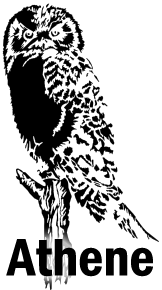Athene Overview
 The genus Athene contains several small owls including noctua
(Little Owl) also known as the owl of Athena (or Athene). The stereotype of the studious,
scholarly owl is probably derived in part from this association with Athena, the
Greek goddess of wisdom, strategy, handicrafts, reason, and heroic endeavor.
The genus Athene contains several small owls including noctua
(Little Owl) also known as the owl of Athena (or Athene). The stereotype of the studious,
scholarly owl is probably derived in part from this association with Athena, the
Greek goddess of wisdom, strategy, handicrafts, reason, and heroic endeavor.
Goals / Purpose
Athene is a tool designed to help students learn to program by providing
many concrete, discrete tasks whose solutions can be automatically verified to
provide immediate feedback to students. This model is the antithesis of the
semester-long project. Following this approach, students complete many dozens
of assignments during the semester instead.
Student Experience
Students in a particular class are presented with a sequence of programming
assignments for that class. Each assignment consists chiefly of a problem
number, name, full description and a due date. Based on the description
provided for the assignment, the student writes a solution to the assignment
and submits it for immediate scoring. Each submission is called an attempt and
immediately receives a score via an automated scoring mechanism.
Typically the student will be unsuccessful on their first attempt; in this
case feedback is provided, specifying why the solution was not completely
acceptable. While the exact feedback is dependent upon the curriculum author,
generally specific test cases (i.e., exact test input and expected output) are
provided to the student. The student is then encouraged to improve upon their
solution and submit another attempt.
Again, the specific policies are highly configurable, but generally
multiple attempts are allowed without penalty. This allows the student to
iterate and hopefully master each assigned task, rather than try once and fail
without feedback. Generally assignments and student attempts remain available
to the student for later reference, including the option to submit an attempt
for scoring and feedback whose due date has passed (not for the grade but for
the feedback).
Teacher Experience
The teacher for a particular class primarily creates assignments for the
students. This consists of selecting and ordering problems from a problem-bank,
also known as a curriculum.
Teachers may view and export the scores, number of attempts, actual
submissions, etc. for their class and individual students. Teachers may also
force an attempt to be regraded or override the automated score for an
assignment.
Follow this link to setup Canvas integration.
Curriculum Author Experience
The author of a curriculum is responsible for creating a collection of
problems designed to progressively challenge the student. Curricula are
intended to to survive from semester to semester and improve as additional
(incorrect) solutions are discovered.
Contact
For more information about how you can use this tool in your own courses contact
dwayne.towell@lipscomb.edu.
